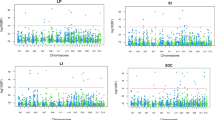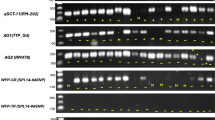Abstract
The F 1 and F 2 generations of a twenty parent fractional diallel cross of opium poppy (P. somniferum L.) were analyzed for combining ability for ten quantitative and five quality (alkaloids) traits. The results indicated significant differences among the parents for combining ability for all the traits. The GCA and SCA components of variances were significant for all the characters. However, the SCA component of variance (δ 2s) was predominant indicating the preponderance of non-additive gene effect for all the traits except for leaves/plant and papaverine in F1 hybrids. The average degree of dominance (δ 2s/δ 2g) was more than unity indicating over dominance and also confirming non-additive mode of gene action. Among the parents IS-16, IS-13 and NBRI-1 for early flowering, BR226 and BR241 for branches/plant, capsule weight/plant, seed yield/plant and husk yield/plant, BR227 for leaves/plant, UO1285 for capsule size and opium yield/plant, NBRI-5 for husk yield/plant, morphine, codeine, and thebaine and ‘Papline’ for plant height and papaverine content were found good general combiners. Parent ND1001 was good combiner for codeine and narcotine content. Inclusion of good general combiners in a multiple crossing program or an intermating population involving all the possible crosses among them subjected to bi-parental mating may be expected to offer maximum promise in breeding for higher opium, seed yield and alkaloid contents.
Similar content being viewed by others
References
Bhandari MM (1990) Outcrossing in opium poppy (P. somniferum L.). Euphytica 48:167–169. doi:10.1007/BF00037196
Cruz CD, Regai AJ (1994) Modelos biometricos applicados ao melhoramento genetic. Universidade Federal de Vicosa, Imprensa Universitara. Vicosa, Minas Gerais, Brazil
Derck JP (1968) A comparison of two methods for predicting changes in the distribution of gene frequency when selection is applied repeatedly to a finite population. Biometrics 13:127–141
Dudley JW, Moll RH (1969) Interpretation and use of estimates of heritability and genetic variance in plant introduction. Crop Sci 9:257–262
Falconer DS (1989) Introduction of quantitative genetics, 3rd edn. Longaman, Essex, pp 275–276
Gardner CO (1963) Estimation of genetic parameters in cross fertilizing plants and their implication in plant breeding. statistical genetics and plant breeding. NAS-NRS Publ 982:225–252
Grafius JE (1959) Heterosis in barely. Agron J 51:551–554
Griffing B (1956) Concept of general and specific combining ability in relation to diallel crossing system. Aust J Biol Sci 9:463–493
Hayman BI (1954) The theory and analysis of diallel crosses. Genetics 39:789–809
Jensen NF (1970) A diallel selective mating system for cereal breeding. Crop Sci 10:629–635
Kandalkar VS, Nigam KB (1993) Combining ability for physiological characters and opium yield in opium poppy (Papaver somniferum L.). Indian J Genet 53:34–39
Kandalkar VS, Patidar H, Nigam KB (1992) Combining ability analysis for harvest index, seed yield and important component characters in opium poppy (Papaver somniferum L.). Indian J Genet 52:275–279
Kempthorne O, Curnow RN (1961) The partial diallel cross. Biometrics 17:229–250. doi:10.2307/2527989
Khanna KR, Shukla S (1986) HPLC investigation of the inheritance of major opium alkaloids. Planta Med 54:157–158. doi:10.1055/s-2007-969106
Khanna KR, Shukla S (1989) Gene action in opium poppy (Papaver sominferum L.). Indian J Agric Sci 59:124–126
Kuehl RO, Rawling JO, Cockerham CC (1968) Reference populations for diallel experiments. Biometrics 24:881–902. doi:10.2307/2528878
Lal RK, Sharma JR (1991) Genetics of alkaloids in Papaver sominferum. Planta Med 57:271–274. doi:10.1055/s-2006-960088
Patra NK, Ram RS, Chauhan SP, Singh AK (1992) Quantitative studies on the mating system of opium poppy (P. somniferum L.). Theor Appl Genet 84:299–302. doi:10.1007/BF00229486
Rahman M, Patwary AK, Miah AJ (1981) Combining ability in rice. Indian J Agric Sci 15:543–546
Robinson HF, Cockerham CC, Moll RH (1960) Studies on estimation of dominance variance effects of linkage bias in Biometrical Genetics. Pergaman Press, New York, pp 171–177
Satyanarayana PV, Reddy MSS, Kumar I, Madhuri J (2000) Combining ability studies on yield and yield components in rice. Oryza 37:22–25
Shukla S, Khanna KR, Singh SP (1993) Genetic architecture of narcotine in opium poppy (Papaver somniferym L.). Indian J Plant Genet Resour 7:139–142
Shukla S (1992) Genetics of seed yield and its contributing traits in opium poppy (Papaver somniferum L.). Proc Nat Acad Sci India 62((B)II):213–217
Shukla S, Khanna KR (1997) Genetic architecture of opium yield, seed yield and its components in opium poppy (P. somniferum L.). Advances in Plant Science Research (Ed. Dhir), vol 5 & 6. Interational Book Distributors, Dehradun, pp 43–55
Shukla S, Singh SP (1999) Genetic systems involved in inheritance of papaverine in opium poppy (Papaver Somniferum L.). Indian J Agric Sci 69:44–47
Shukla S, Singh SP (2004) Exploitation of interspecific crosses and its prospects for developing novel plant type in opium poppy (P. somniferum L.). In: Trivedi PC (ed) Herbal drugs and biotechnology. Pointer Publishers, Jaipur, pp 210–239
Singh HP, Tewari RK, Singh SP, Singh AK, Patra NK (2002) Genetic studies in opium poppy (P. somniferum L.). J Med Arom Plant Sci 24:762–765
Singh SP, Singh HN (1987) Combining ability in relation to year interaction in okra. Abelmoshus esculentus (L.) Moench. SABRAO J 19:93–101
Singh SP, Singh HP, Singh AK, Verma RK (2001) Identification of parents and hybrids through line × tester analysis in opium poppy (Papaver somniferum). J Med Arom Plant Sci 22(23):327–330
Singh SP, Shukla S, Khanna KR (1995) The opium poppy. In: Chaddha KL, Gupta R (eds) Advances in horticulture: medicinal and aromatic plants, vol 11. Malhotra Publishing house, New Delhi, pp 535–574
Singh SP, Shukla S, Khanna KR (1996) Diallel analysis for seed yield and its components in opium poppy (P. somniferum). J Med Arom Plant Sci 18:259–263
Singh SP, Shukla S, Khanna KR (1999) Breeding strategies in opium poppy (Papaver Somniferum L.) at National Botanical Research Institute, Lucknow, India. Appl Bot Abst 19:121–139
Singh SP, Yadav HK, Shukla S, Chatterjee A (2003) Studies on different selection parameters in opium poppy (P. somniferum L.). J Med Arom. Plant Sci 25:8–12
Singh SP, Shukla S, Yadav HK (2004) Multivariate analysis in relation to breeding system in opium poppy (Papaver somniferum L.). Genetika 36:111–120. doi:10.2298/GENSR0402111S
Sprague GF (1966) Quantitative genetics in plant improvement. In Plant Breeding (Ed. Kenneth, J Frey). A symposium on Plant Breed. Iowa State Univ Press Ames, Iowa, pp 315–354
Verma OP, Srivastava HK (2004) Genetic component and combining ability analysis in relation to heterosis for yield and associated traits using three diverse rice growing ecosystems. Field Crops Res 88:91–102. doi:10.1016/S0378-4290(03)00080-7
Acknowledgments
Authors thank to the Director, NBRI, Lucknow for encouragement and facilities provided during the investigation. Financial support given by Chief Controller Factories (CCF), Govt. Opium and Alkaloids Works, Dept. of Revenue; Ministry of Finance, Govt. of India, Now Delhi is gratefully acknowledged. H. K. Yadav also thanks to CSIR for financial Support.
Author information
Authors and Affiliations
Corresponding author
Rights and permissions
About this article
Cite this article
Yadav, H.K., Shukla, S. & Singh, S.P. Genetic combining ability estimates in the F1 and F2 generations for yield, its component traits and alkaloid content in opium poppy (Papaver somniferum L.). Euphytica 168, 23–32 (2009). https://doi.org/10.1007/s10681-008-9872-5
Received:
Accepted:
Published:
Issue Date:
DOI: https://doi.org/10.1007/s10681-008-9872-5




